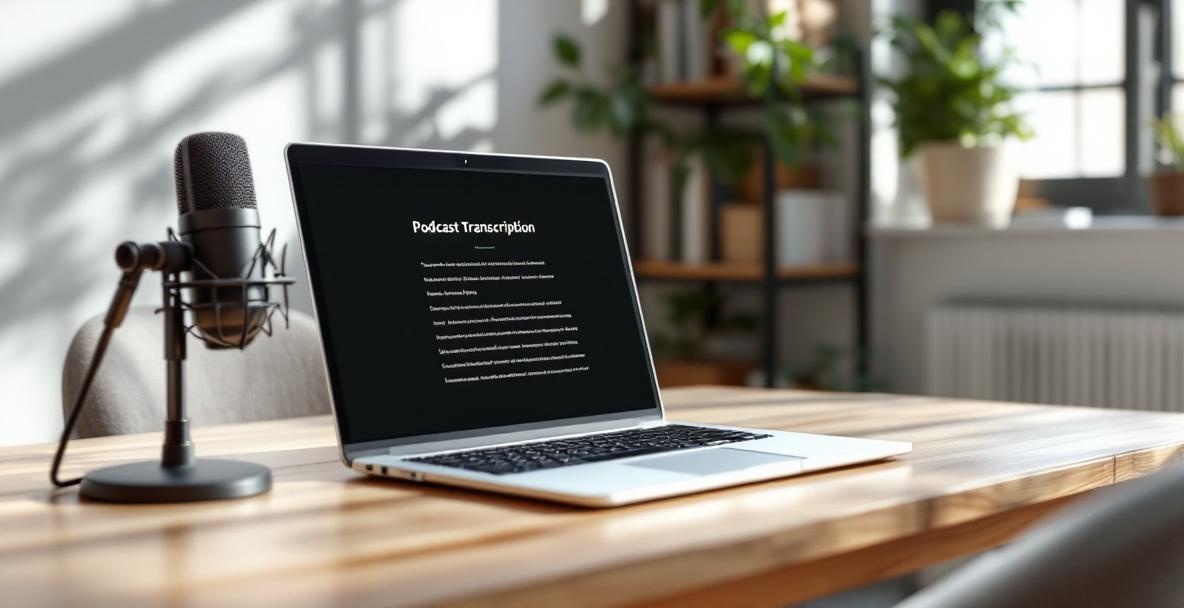Your podcast deserves to be heard by everyone, and transcription services give you a secret weapon to make that happen. Transcriptions turn spoken words into written text that cuts through noise and helps more people find your work. They serve as an extra way to reach listeners and boost your online presence. If you want your episodes to be easily found and enjoyed in different ways, a clear transcript can be the difference between staying small and breaking through.
Step Into the World of Podcast Transcriptions

Podcast transcriptions act as a bridge between audio and text. They change your recorded words into a written copy that reaches more listeners in everyday settings. With a transcript, you give your fans the freedom to read your episodes anywhere, whether they are in a quiet cafe or on a noisy commute. This simple exchange of sound for text opens up exciting ways to boost engagement and share your message.
Transcripts do more than just convert words to text. They let your audience interact with your content in fresh ways, especially when they need to read in a quiet place, quickly scan for information, or simply pick the format that suits their lifestyle. For creators, having a transcript means more opportunities to repurpose material and uncover insights from detailed audience analytics.
What used to be a slow, expensive job is now fast and affordable. Transcription is no longer a luxury add-on; it has grown into an essential tool for podcasters who want to keep pace with a busy digital world. With options that fit different budgets and needs, you can find a service that offers the right balance of speed and accuracy.
Why Accessibility Is a Must in Podcasting

Being accessible is not just a trendy idea; it is about making sure every single listener can join the conversation. When you care about accessibility, you open your content to a wider and more diverse audience. This is a smart move that helps your podcast grow while doing the right thing for all who need it.
There are several challenges that may stop someone from fully enjoying your audio-only show. For example, people who are deaf or hard-of-hearing-an estimated 466 million around the globe-need a text version to join in. In addition, non-native speakers, individuals with hearing difficulties, and folks in environments where sound is hard to hear all benefit from having a transcript to follow along.
Many people learn best through different styles. Some remember facts better when they see them instead of hearing them. By offering both text and audio, you cater to various learning methods, and your listeners can choose the style that works best for them. This extra step makes your podcast more inclusive and easy to follow.
Bringing in a Wide Range of Listeners
Transcriptions are one of the best tools to welcome a broad range of listeners. For those who are deaf or hard-of-hearing, a transcript turns a challenging audio experience into something clear and engaging. They can read your ideas, stories, and tips in a way that suits their everyday needs.
Non-native speakers often find that reading while listening strengthens their understanding. They can catch new words or tricky expressions and feel more confident about following the conversation. This dual approach helps make your episodes accessible for everyone, no matter their language skills.
Everyday life can interrupt even the best recordings. Think of someone on a crowded bus, a parent trying to keep kids asleep, or a worker in a quiet office who cannot turn up the volume. A transcript gives these people a chance to enjoy your podcast when listening out loud just isn’t an option. With multiple ways to interact, you boost both audience reach and listener satisfaction.
Fair Play and Responsibility
As the podcast scene matures, paying attention to accessibility has become more important than ever. Although podcasts do not have the same strict rules as some media, many organizations are now looking for content that everyone can access. Laws are changing all over, and more guidelines mean that better accessibility today can help you dodge potential issues tomorrow.
Offering transcripts now shows you are ahead of the curve and care about equal access. It helps you meet evolving standards and proves your commitment to serving everyone. This approach not only steers clear of future legal headaches but also highlights your values of inclusivity and fairness.
When you make your episodes accessible, you truly stand by your listeners. It is a clear statement that your show is built for everyone and that you care deeply about keeping your content available across all formats. Such commitment builds trust and loyalty among your audience.
How Podcast Transcription Services Function
Knowing how transcriptions are created can help you choose the right service. Although turning audio into text might sound straightforward, the methods can vary, and each option has its benefits and limits.
Most services work in a few simple steps. You start by uploading your audio file, select the extras you might need, such as labeling speakers or adding time stamps, and then wait for your complete transcript. The final text you receive reflects the quality of work the service promises to deliver, and you usually get your copy within the expected time.
Many modern services offer you different formats so you can use your transcript wherever you like. Whether it is a simple text file, a well-formatted document, or an interactive version linked to your audio, this flexibility ensures you can get the most out of your valuable podcast content.
Comparing Human and Automated Transcription
There are two main approaches to generate a transcript. One method uses trained professionals who listen carefully to each word, and the other relies on advanced software that quickly converts speech to text. Each brings its own strengths to the table.
Human-powered transcription generally offers the highest accuracy. It is especially helpful when your podcast features several speakers, technical terms, or background noises that need sorting out. A human ear can detect context and clarity better than software, though this attention to detail means the service might cost more and take a bit longer.
On the other hand, automated transcription uses technology to produce results in a flash at a lower price. These tools work well with clear speech and standard accents but may struggle with complex language or multiple speakers. Many podcasters now combine both methods by starting with an automated draft and then having a person review it, achieving a great mix of speed and accuracy.
What a Good Transcription Service Provides
When looking into different services, it helps to know what features to expect. A solid provider will be upfront about how accurate their transcripts are, how fast they work, and what they charge.
You want a service that promises high precision, ideally above 95% for clear audio, and even better if they offer a clean, polished version. Look for extras such as labeling speakers, inserting regular time stamps, and handling technical terms with care. A good service explains all of this and shows you clear examples of their work, so you know you are getting top-quality output.
Turnaround times can vary widely. Automated services can deliver in a matter of minutes, while human transcription may take one to three days depending on your needs. Prices are usually set per audio minute, so having a clear idea of your budget and episode length will help you pick a service that meets both your quality and cost goals.
Elevating SEO and Discoverability with Transcripts

Transcripts do more than improve accessibility. They work wonders for your online presence by making every word searchable on the web. Search engines can’t listen to audio, but they can easily read text, which means your well-crafted transcript brings your content into the spotlight.
When you add a complete transcript to your episode page, you are giving search engines a rich resource to index. This helps your podcast appear when people search for topics you cover, boosting your organic search traffic and giving your show more entry points online.
If you are serious about growing your audience, think of transcripts as a secret advantage. They help your episodes get discovered in ways that audio files simply cannot, opening the door to new listeners who find you through relevant search terms and keywords.
Improving Your Rankings on Search Engines
A full transcript adds a massive library of text that search engines love to review. Instead of relying only on a short title and description, the full text tells search engines exactly what your episode is about. This detailed information improves your chances of ranking for both general topics and more specific searches.
Having extra text on your site also keeps visitors around longer. When people read along or explore the transcript, they spend more time on your page, and search engines see that as a sign of quality. This engagement can help push your show higher in search results, making it easier for new fans to discover your work.
Fine-Tuning Transcripts for Better SEO
To get the most out of your transcript for search engines, it helps to be a little strategic. Start by placing your transcript on the same page as your audio player to create a smooth experience for your visitors. Use proper headings and format the text so that search engines pick out the most important parts of your conversation.
Work your main keywords into the transcript in a natural way. You might even create a detailed post for each episode, adding extra notes and images that support the conversation. This extra effort turns your transcript into a robust resource that benefits both your SEO and your audience’s experience.
Finding the Best Transcription Service for Your Podcast

Choosing the right transcription service means thinking about what your podcast really needs and how much you are willing to invest. With so many options available, it pays to know your own show’s quirks and budget before making a decision. A good service makes your content more accessible and can help boost your overall exposure.
Begin by considering your podcast’s unique traits. Do you often have several speakers, specialized topics, or varied accents? How long are your episodes and how frequently do you publish? These factors help you narrow down the choices and find a service that matches your specific needs while staying within an affordable range.
Remember that investing in a high-quality transcript can pay off down the line by increasing your visibility and listener loyalty. It might be wise to spend a little extra for better accuracy, especially if your show covers technical or complex subjects. A quality transcript is a step toward a more professional and reliable podcast.
How to Compare Transcription Providers
When you shop around, focus on a few key details. Accuracy is crucial, as even small errors can lead to misunderstandings and hurt your show's image. Request a sample transcript or try a trial service to see if they handle tricky audio, background noise, and mixed accents well.
Also, check how each service fits into your workflow. Some providers offer tools that automatically process your episodes or integrate directly with your publishing platform. These conveniences can save you time and might be worth a slightly higher rate. Lastly, compare turnaround times to make sure they match your release schedule and keep your production running smoothly.
Weighing Cost Against Quality
Prices for transcription services can differ a lot, so it is important to find a balance between cost and quality. Automated services often charge around $0.10 to $0.25 per minute and work well when your audio is clear. But if your episodes have multiple voices or complicated terms, a human or hybrid service might be a better choice-even if it costs a bit more.
Many podcasters find that a hybrid service, which starts with automated transcription and then uses human review, offers the best of both worlds. This middle ground delivers high-quality transcripts without breaking the bank. As your podcast grows, you may gradually upgrade your service to keep pace with your expanding audience.
Wrapping Up: How Transcriptions Transform Your Podcast
Transcriptions do much more than add words to your website. They are a powerful tool that boosts your show's accessibility, improves its search ranking, and gives your audience more ways to enjoy your content. By presenting your episodes in both audio and text, you show a real commitment to reaching everyone who wants to listen. The SEO gains and improved user engagement can truly set your podcast apart.
Ready to make your podcast more accessible, discoverable, and engaging? Visit Castee today to explore our comprehensive podcast marketing solutions designed to enhance your content's reach. Our platform is designed to help podcasters like you amplify your voice, achieve organic growth, and build a thriving, engaged community around your show. Let us help you transform your podcast transcripts into powerful marketing assets that work around the clock to grow your audience.
Leave a Reply